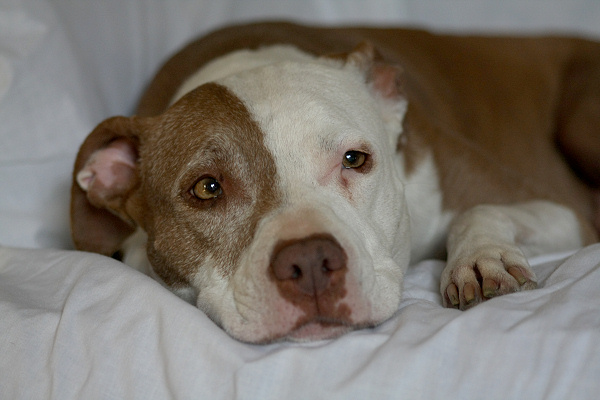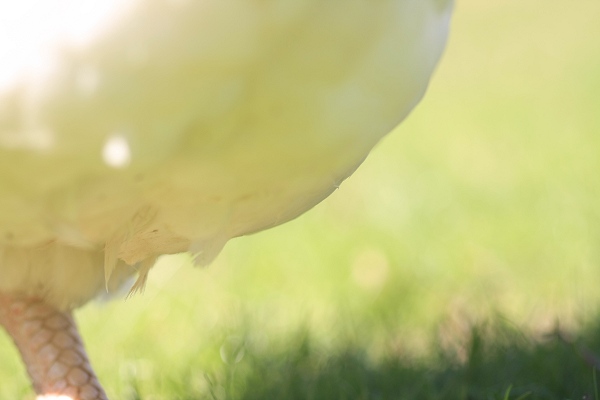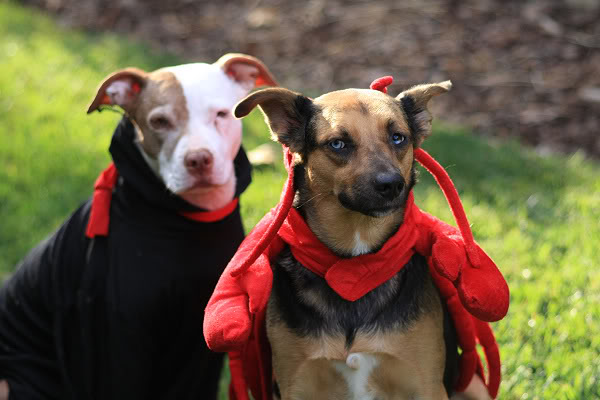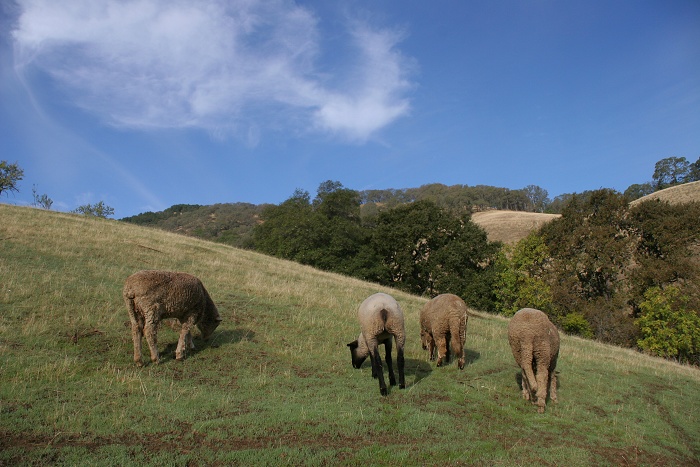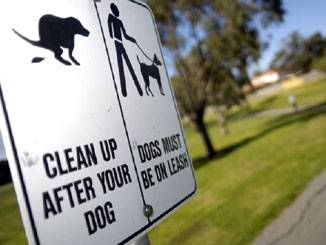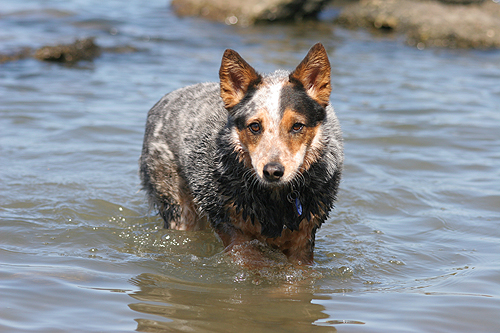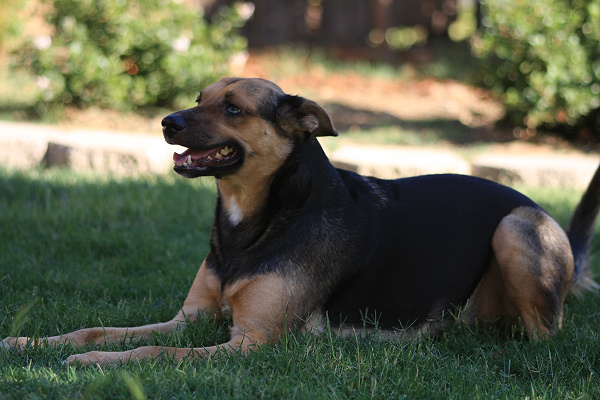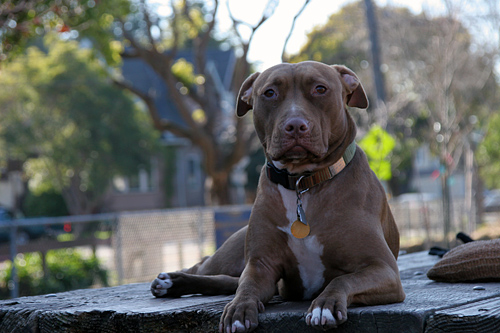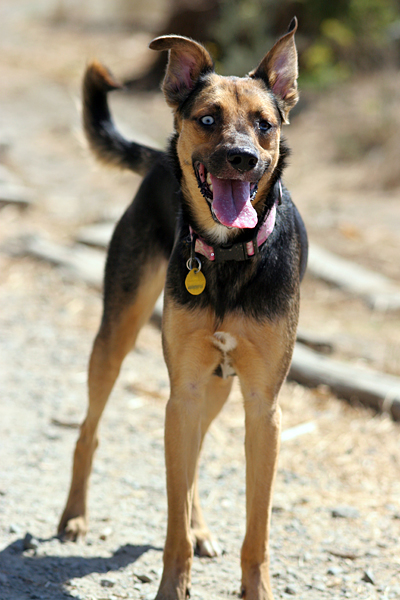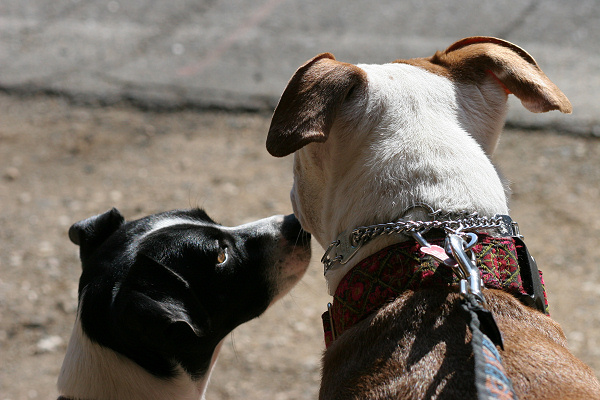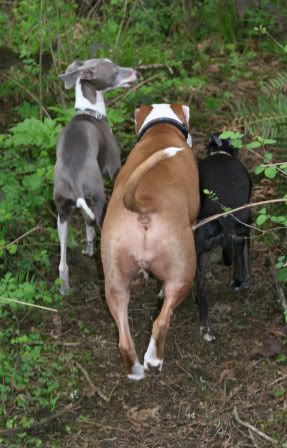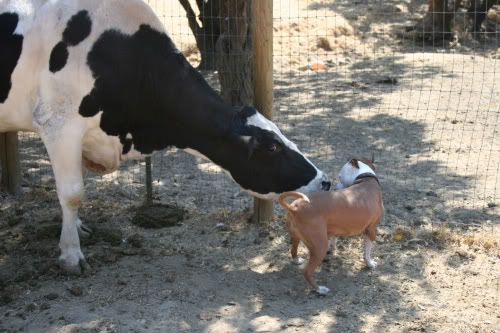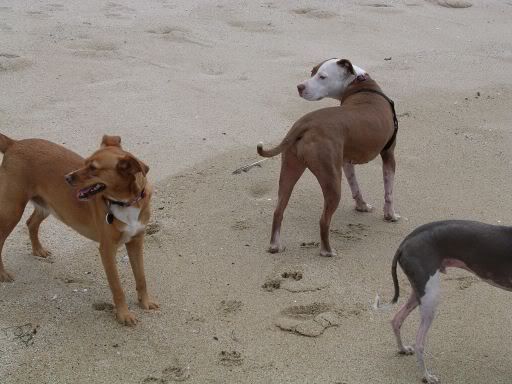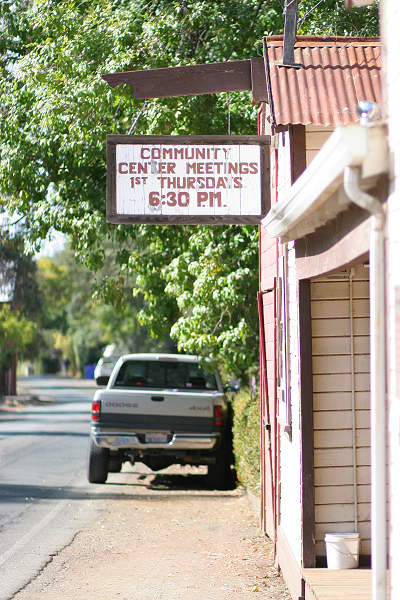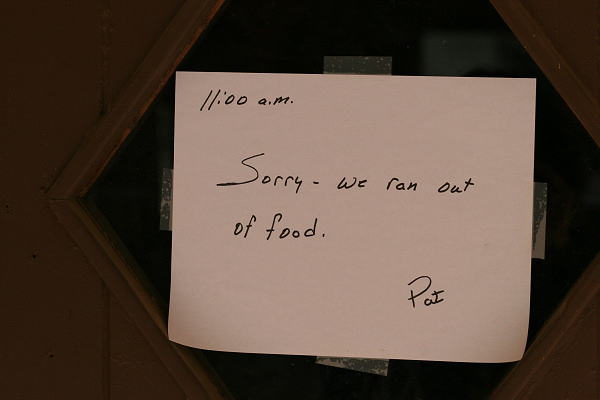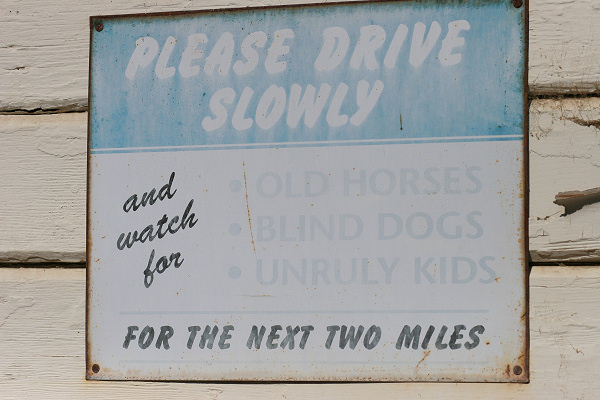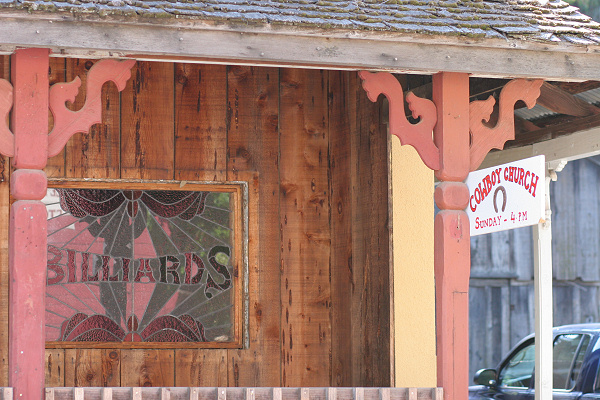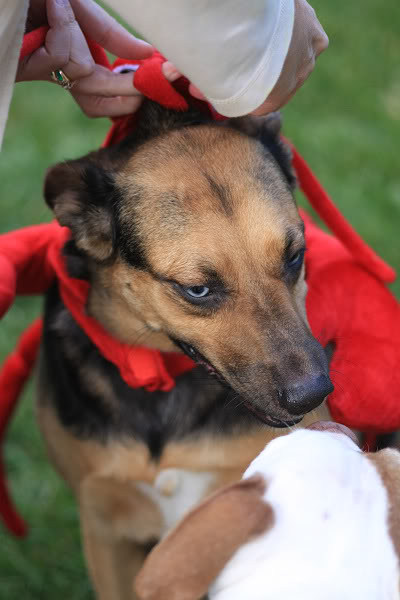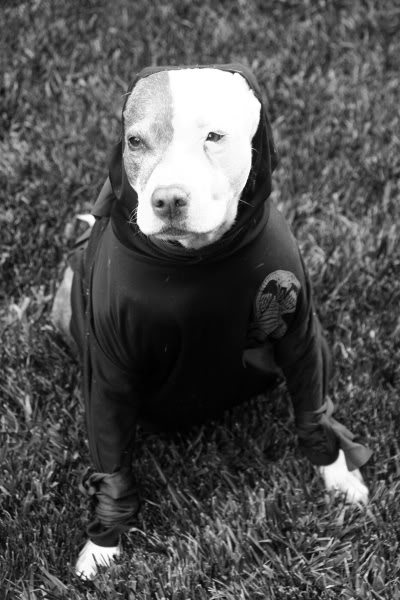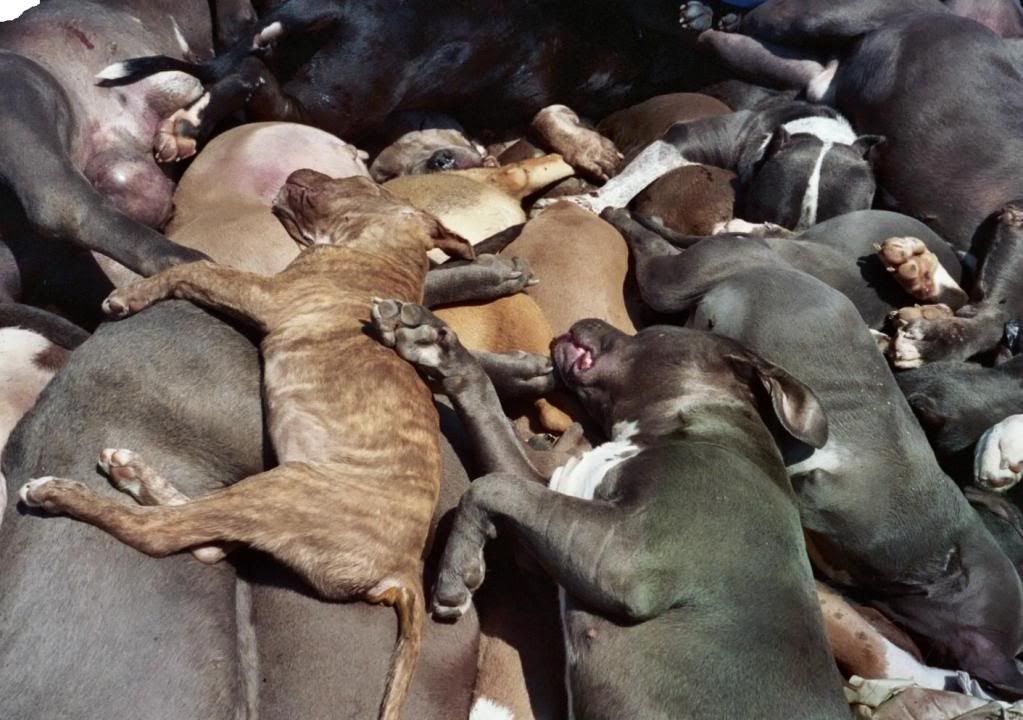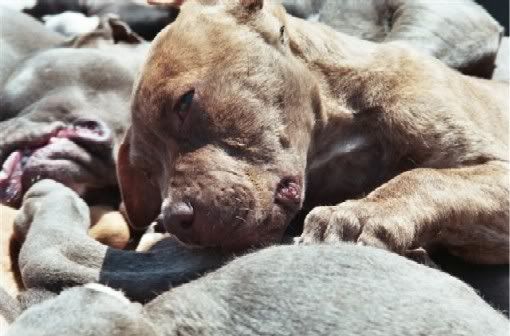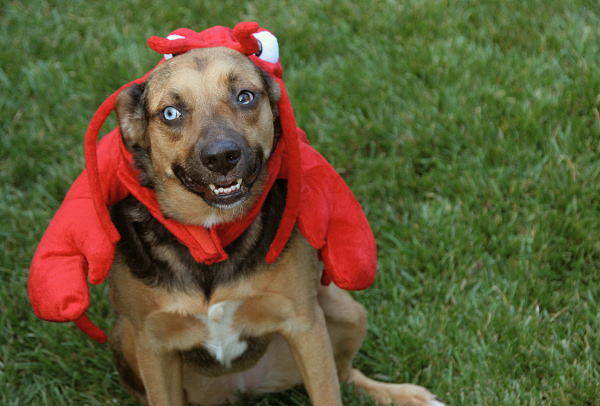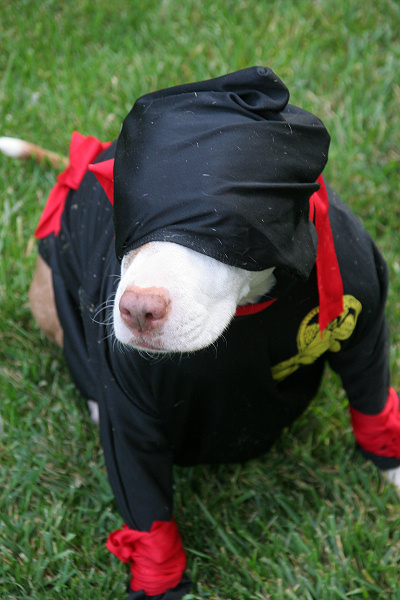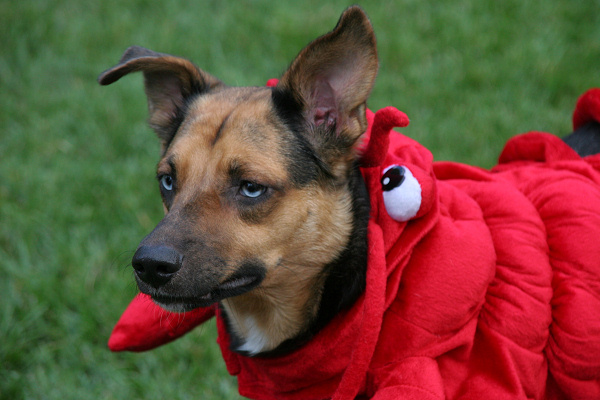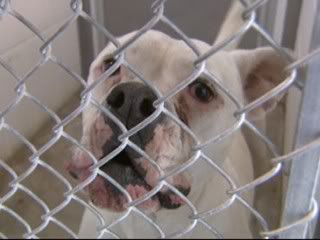So there's these two loose dogs. A man, A MAN, is able to get the dogs to come to him with biscuits. He chained up one dog, while the other remained loose. He calls police.
And they send one female police officer. What? Are living in the 21st century or something? Clearly this was a job for a man. The sole woman officer realized the error of her joining the police force and called animal control. Animal control sent one female officer. Holy crap, what has this world come to when the only officers to respond to a loose dog call are WOMEN who cannot handle things like dogs or catch poles or, you know, doing their job or something. MEN CAN BECAUSE MEN HAVE GUNS AND PENISES.
According to the man who called police, "it never would have happened, he said, if one woman had not been sent alone".
That's right! She should have had a male escort, preferably a relative, and she probably should have been wearing a burka. The dogs would have sensed her sensitive, femininity and respected that. The man could have stepped in and handled those two dogs.
Anyway, so according to the male witness, ALL HELL BROKE LOOSE AND THE ANIMAL CONTROL OFFICER WAS EATEN ALIVE. Probably for being a woman. And by eaten alive, I mean she suffered two puncture wounds to her calf.
Reading that article was painful for my eyes. Sure, one person was ill-equipped to deal with these dogs, maybe.
But let me share a story with you.
Back in the day I was a volunteer at a large county dog and cat shelter. I loved it. One day, I said to myself - self, you are ready to take that intact Lab and intact Rottweiler out by yourself to the exercise area BECAUSE YOU ARE A SUCKER FOR PUNISHMENT, YOU IDIOT. But I neglected to listen to the caps section of my self.
So there I was with two large, intact, male, hormonal, idiot dogs. And what should happen? The Lab got pissed off that the Rottweiler was sniffing HIS GRASS. So they duked it out. Of course, I happened to be standing right between them. The Rottie ripped open my pant leg, biting me. The Lab managed to avoid eating me and hit his target, the black and tan dog currently confusing my pant leg for another dog. The Lab got the Rottie by the throat and had him pinned to the ground and I'm all HOLY CRAP I FAIL AT LIFE.
When out of nowhere, my heroine arrived. She was an animal control officer half my size. As she ran into the exercise area, I got out of her way (otherwise she would have shoved me out of the way). She picked up that 90lb Lab like he was made of cotton candy and when that Rottweiler made to go after the now-dangling retriever, she gave him the look of death, stopping him in his tracks.
Now if SHE had been the sole woman animal control officer to arrive on the scene, she would have kicked those two pit bulls' asses. They would not have bit her calf, because they would be dangling by the scruffs of their necks. I realize not all ACO's are as bad-ass as my ACO. And that's fine.
But please, Quad City Times, get with the times. Your sexism is underwhelming and unappreciated. By me, mainly, but maybe by other women and enlightened menfolk.
Saturday, October 31, 2009
Friday, October 30, 2009
Woman charged with making up dog bite report
A woman has pleaded not guilty for lying about the dog who bit her child on the face, inflicting 70 stitches worth of damage.
The mother blamed a stray pit bull.
The dog was actually her own husky.
Maybe I could understand it a little more if the woman tried to keep her dog, but she had the dog killed. Why make up the story? I mean, she could be avoiding a possible misdemeanor charge for falsifying a report and thus wasting taxpayer's money having police/animal control search for a non existent dog. And now we can waste even more of our money pressing charges against her. Money wastage for the win!
No mention of the child and how she is doing. Well, I hope.
The mother blamed a stray pit bull.
The dog was actually her own husky.
Maybe I could understand it a little more if the woman tried to keep her dog, but she had the dog killed. Why make up the story? I mean, she could be avoiding a possible misdemeanor charge for falsifying a report and thus wasting taxpayer's money having police/animal control search for a non existent dog. And now we can waste even more of our money pressing charges against her. Money wastage for the win!
No mention of the child and how she is doing. Well, I hope.
Thursday, October 29, 2009
How photography impacts my world
Mina decided she would like to learn more about photography by leaping on my lesson plan.
I'm taking the New York Institute of Photography's "The Complete Course in Professional Photography" course (redundant, yes).
I love photography. I have loved it since I first handled my dad's film minolta as a kid. There was something enchanting about taking something I had seen and making it almost permanent. As I got older, I lost some interest in photography, due in part to my teenage inability to afford film and printing. I took a class in high school and stopped photography to pursue animal science at university. My dreams were of becoming a vet, a behaviorist, something to do with animals.
Photography was all but forgotten.
And then.
When I started working at an animal sanctuary, I realized I was surrounded by beautiful creatures amidst a pastoral, bucolic setting. More than that, I wanted people to meet the animals who I worked with, animals who most people related to on their plates for dinner.
So three years ago, my parents kindly purchased me my first digital SLR, a Canon EOS 20d for X-mas/birthday. Oh heaven! I fumbled and finagled my way through learning the camera. I realized I still had the eye, an ability to frame a subject in a pleasing manner. Not perfect, just raw data ready to be refined.
I purchased my second camera this year - a Canon EOS 40D refurbished body (and saved hundreds of dollars). It is perhaps unfathomable to some, but I adore the weight of two hefty cameras around my shoulders, the power of stilling time in my grasp. Someday I will have a plethora of lenses but, for now, I have three - a zoom, a prime, a telephoto. They are enough to keep me content.
 The class is helping me refine some of my skills. Of course it isn't book knowledge that is helping me, it's the experience, the action of pressing a button, modifying settings, appreciating lighting and doing all I can to enhance the subject. Like all photographers, I am my worst critic - I take hundreds of photos daily, of which ten might qualify as decent. I've calculated that, in the past three years, I have spent more than 2,000 hours taking pictures. I could do it all day for the rest of my life.
The class is helping me refine some of my skills. Of course it isn't book knowledge that is helping me, it's the experience, the action of pressing a button, modifying settings, appreciating lighting and doing all I can to enhance the subject. Like all photographers, I am my worst critic - I take hundreds of photos daily, of which ten might qualify as decent. I've calculated that, in the past three years, I have spent more than 2,000 hours taking pictures. I could do it all day for the rest of my life.
Now, I'm no expert (apparently it takes about 10,000 hours, heh), but I hope to be someday. More importantly, I hope my photography gives people pause, helps to capture the intelligence, emotion and beauty of other species, especially farm(ed) animals. Which is why when I received this gem of an email today at work, I was tickled:
Your pictures of the animals at the sanctuary convinced me to stop eating them.
That was it. It made everything I do, all the heart-ache, dedication, work, struggle, all worth it. No matter where you fall on the omni-vegan debate, there is nothing more empowering than knowing that something you did created a positive change in someone's life.
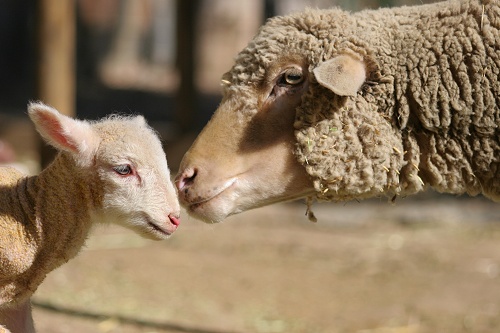 It's been that way with Mina too. I've had people tell me that my pictures of Mina, of her stillness, her gentleness, her poise, beauty, HER essence helped them to get over fears about pit bulls. Some went on to adopt or consider a pit bull for adoption. Others made a point to approach other pit bull owners and ask to pet their dogs (let me tell you a secret: Nothing makes a pit bull guardian/owner happier than when someone asks to pet their dog. Nothing. It might even make them cry a little. Not me, of course. That would be silly).
It's been that way with Mina too. I've had people tell me that my pictures of Mina, of her stillness, her gentleness, her poise, beauty, HER essence helped them to get over fears about pit bulls. Some went on to adopt or consider a pit bull for adoption. Others made a point to approach other pit bull owners and ask to pet their dogs (let me tell you a secret: Nothing makes a pit bull guardian/owner happier than when someone asks to pet their dog. Nothing. It might even make them cry a little. Not me, of course. That would be silly).
So if you have a camera, even if you don't know how to use it well, take it and capture moments. Share them with your friends, family, coworkers, blog viewers, etc. ad naseum. You can make a difference in how others see the world.
I'm taking the New York Institute of Photography's "The Complete Course in Professional Photography" course (redundant, yes).
I love photography. I have loved it since I first handled my dad's film minolta as a kid. There was something enchanting about taking something I had seen and making it almost permanent. As I got older, I lost some interest in photography, due in part to my teenage inability to afford film and printing. I took a class in high school and stopped photography to pursue animal science at university. My dreams were of becoming a vet, a behaviorist, something to do with animals.
Photography was all but forgotten.
And then.
When I started working at an animal sanctuary, I realized I was surrounded by beautiful creatures amidst a pastoral, bucolic setting. More than that, I wanted people to meet the animals who I worked with, animals who most people related to on their plates for dinner.
So three years ago, my parents kindly purchased me my first digital SLR, a Canon EOS 20d for X-mas/birthday. Oh heaven! I fumbled and finagled my way through learning the camera. I realized I still had the eye, an ability to frame a subject in a pleasing manner. Not perfect, just raw data ready to be refined.
I purchased my second camera this year - a Canon EOS 40D refurbished body (and saved hundreds of dollars). It is perhaps unfathomable to some, but I adore the weight of two hefty cameras around my shoulders, the power of stilling time in my grasp. Someday I will have a plethora of lenses but, for now, I have three - a zoom, a prime, a telephoto. They are enough to keep me content.
 The class is helping me refine some of my skills. Of course it isn't book knowledge that is helping me, it's the experience, the action of pressing a button, modifying settings, appreciating lighting and doing all I can to enhance the subject. Like all photographers, I am my worst critic - I take hundreds of photos daily, of which ten might qualify as decent. I've calculated that, in the past three years, I have spent more than 2,000 hours taking pictures. I could do it all day for the rest of my life.
The class is helping me refine some of my skills. Of course it isn't book knowledge that is helping me, it's the experience, the action of pressing a button, modifying settings, appreciating lighting and doing all I can to enhance the subject. Like all photographers, I am my worst critic - I take hundreds of photos daily, of which ten might qualify as decent. I've calculated that, in the past three years, I have spent more than 2,000 hours taking pictures. I could do it all day for the rest of my life.Now, I'm no expert (apparently it takes about 10,000 hours, heh), but I hope to be someday. More importantly, I hope my photography gives people pause, helps to capture the intelligence, emotion and beauty of other species, especially farm(ed) animals. Which is why when I received this gem of an email today at work, I was tickled:
Your pictures of the animals at the sanctuary convinced me to stop eating them.
That was it. It made everything I do, all the heart-ache, dedication, work, struggle, all worth it. No matter where you fall on the omni-vegan debate, there is nothing more empowering than knowing that something you did created a positive change in someone's life.
 It's been that way with Mina too. I've had people tell me that my pictures of Mina, of her stillness, her gentleness, her poise, beauty, HER essence helped them to get over fears about pit bulls. Some went on to adopt or consider a pit bull for adoption. Others made a point to approach other pit bull owners and ask to pet their dogs (let me tell you a secret: Nothing makes a pit bull guardian/owner happier than when someone asks to pet their dog. Nothing. It might even make them cry a little. Not me, of course. That would be silly).
It's been that way with Mina too. I've had people tell me that my pictures of Mina, of her stillness, her gentleness, her poise, beauty, HER essence helped them to get over fears about pit bulls. Some went on to adopt or consider a pit bull for adoption. Others made a point to approach other pit bull owners and ask to pet their dogs (let me tell you a secret: Nothing makes a pit bull guardian/owner happier than when someone asks to pet their dog. Nothing. It might even make them cry a little. Not me, of course. That would be silly).So if you have a camera, even if you don't know how to use it well, take it and capture moments. Share them with your friends, family, coworkers, blog viewers, etc. ad naseum. You can make a difference in how others see the world.
Wednesday, October 28, 2009
Accidental photo
I take all the photos for the place where I work - Animal Place. On accident, I took this shot of a peeper (aka broiler, aka type of chicken people eat). It's my contribution to the genre of abstract surrealism.
Sunday, October 25, 2009
My cruelty knows no bounds
And, for once, Celeste agrees. Dressing up dogs for Halloween and taking fifty five thousands photographs should be a prosecutable offense.
In other news, here are some sheep from the sanctuary. I tried to get them to stop grazing and face me and the camera, but their butts would not move. You can see that the two sheep on the right (Gwen and Lenny) have tails. The two sheep on the left (Alice & Virginia) have had theirs docked, generally done with a cauterizing knife and no pain relief (ouch). Unlike their wild brethren, most domestic sheep have long, sometimes very woolly tails. If you can manage a good hygiene program, like we do at the sanctuary, maggots are not a problem (in fact, the only sheep who has had problems with maggots was a docked merino ewe). Maggots can become an issue in the fine-wool breeds, like merinos, who have extra folds of skin where moisture and maggots can thrive.
Anyways. Sheep butts!
Friday, October 23, 2009
Dogs who don't need coats
Mina likes to stay warm during the winter. By winter, I mean temperatures below 75 F. Mina is a wimp when it comes to cold weather. I am too.
I was looking at dog coats. Do not ask why. It should be obvious - I am semi-crazy when it comes to Mina and coats. I feel no shame in this, although perhaps I should.
Nevertheless, I came across a coat I liked which led me to a picture of another coat.
Because microfiber fleece isn't just for short-haired dogs! Now dogs with 20 lbs of hair can be loaded down by an insulated, plush fleece coat!
My advice to dog-coat producing companies? Pick dogs who at least look like they might need a coat.
And in case you were wondering, I really like this coat which is being worn by a dog on a 90 F day. Crazy.
I was looking at dog coats. Do not ask why. It should be obvious - I am semi-crazy when it comes to Mina and coats. I feel no shame in this, although perhaps I should.
Nevertheless, I came across a coat I liked which led me to a picture of another coat.
Because microfiber fleece isn't just for short-haired dogs! Now dogs with 20 lbs of hair can be loaded down by an insulated, plush fleece coat!
My advice to dog-coat producing companies? Pick dogs who at least look like they might need a coat.
And in case you were wondering, I really like this coat which is being worn by a dog on a 90 F day. Crazy.
Thursday, October 22, 2009
I'm sorry, your title does not match your photo
Article Title: "Councils to be given more power to kill dangerous dogs"
Matching Photo:
Words are powerful, and they can perpetuate stereotypes and negative connotations. American Pit Bull Terriers are labeled as dangerous dogs. The terms are interchangeable, in this case. When the article mentions loose dangerous dogs and unregistered dangerous dogs, they are NOT referring to dogs who have bitten, mauled, killed, scratched, menaced, or aggressed. They are referring to American Pit Bull Terriers (and any breed covered under the legislation). This is fallacious reasoning, at best. At worst, it creates a system where dogs are killed, that is their futures are snuffed out, because of a label, not because of any actual qualitative behavior. Scary stuff, if you think about it.
Then there is the proposed law itself - killing loose, unregistered dogs without giving owners the right to appeal. What kind of backward thinking is that?
I'm all for making the world a safer place for people. I support reducing the prevalence of loose dogs - it's unsafe for the dogs and for citizens. I support penalizing people who cannot follow current, reasonable laws that require licensing, restraining your dog, etc.
But I do not support killing another living being without giving their owner due process, a chance to legally appeal and possibly reclaim their animal. Even if the animal cannot be reclaimed, I do not support the killing of a healthy (heck, even unhealthy) animal because they look a certain way. To be blunt, that's lame. It's wrong. Pathetic. A poor reflection of humanity (ah, but so many things are, yes).
BROKEN RECORD TIME, RUN FOR THE HILLS! In Australia, dogs are safe. This is true in the United States, Canada and many developed nations. There are a lot of dogs and, statistically, few significant bites and even fewer fatalities. We live alongside a species with sharp teeth and the physical capacity to use them. Amazingly, they manage to refrain from causing physical harm against us on a regular basis. There is no need to kill unregistered dogs of restricted breeds because there is no dog bite epidemic.
Dog bite fatalities are exceedingly rare. When dogs do bite, they show extreme restraint - most dog bites are not serious. There is a point at which we must ask ourselves if these laws being proposed truly enhance our public safety, neutralize it or diminish it. And when we create laws based on the inane notion that you can spot with the naked eye a killer dog or a biting dog, that we can know from the phenotype of a dog whether he is safe or unsafe...we are doing something wrong. We are ignoring the elephant eating peanuts on the sofa, blocking your view of Glee (and that is sinful).
I hope Australia does not follow through with this ludicrous proposal. It will not improve public safety. It will kill healthy animals. That is a shameful thing.
Matching Photo:
Watch out, pooping and/or leashed dogs - YOUR TIME HAS COME.
Now the content, it's frightening. A few days ago, a loose dog with a history of running loose and a possible dangerous dog label in another region of Australia attacked a man walking his two dogs. The dog killed one of the smaller canines and injured the man (thankfully, not severely).
Victoria's Premier John Brumby has a solution: Just kill all unregistered American Pit Bull Terriers.
PROBLEM SOLVED, COMMENCE LIVING IN A SAFER WORLD! Say that loud and proud, people.
Then there is the proposed law itself - killing loose, unregistered dogs without giving owners the right to appeal. What kind of backward thinking is that?
I'm all for making the world a safer place for people. I support reducing the prevalence of loose dogs - it's unsafe for the dogs and for citizens. I support penalizing people who cannot follow current, reasonable laws that require licensing, restraining your dog, etc.
But I do not support killing another living being without giving their owner due process, a chance to legally appeal and possibly reclaim their animal. Even if the animal cannot be reclaimed, I do not support the killing of a healthy (heck, even unhealthy) animal because they look a certain way. To be blunt, that's lame. It's wrong. Pathetic. A poor reflection of humanity (ah, but so many things are, yes).
BROKEN RECORD TIME, RUN FOR THE HILLS! In Australia, dogs are safe. This is true in the United States, Canada and many developed nations. There are a lot of dogs and, statistically, few significant bites and even fewer fatalities. We live alongside a species with sharp teeth and the physical capacity to use them. Amazingly, they manage to refrain from causing physical harm against us on a regular basis. There is no need to kill unregistered dogs of restricted breeds because there is no dog bite epidemic.
Dog bite fatalities are exceedingly rare. When dogs do bite, they show extreme restraint - most dog bites are not serious. There is a point at which we must ask ourselves if these laws being proposed truly enhance our public safety, neutralize it or diminish it. And when we create laws based on the inane notion that you can spot with the naked eye a killer dog or a biting dog, that we can know from the phenotype of a dog whether he is safe or unsafe...we are doing something wrong. We are ignoring the elephant eating peanuts on the sofa, blocking your view of Glee (and that is sinful).
I hope Australia does not follow through with this ludicrous proposal. It will not improve public safety. It will kill healthy animals. That is a shameful thing.
Tuesday, October 20, 2009
Monday, October 19, 2009
Description of the behavior of dogs by experienced & inexperienced people
How people interpret dog behavior has always fascinated me (heck, how *I* interpret dog behavior fascinates me, heh).
A few years ago, I noticed a couple outside a coffee shop allowing two unknown dogs to greet on leash, nose to nose. This is what the two dogs looked like:
- Standing up on tippy-toes
- Stiff body posture
- Ears pulled forward
- Hackles up on both dogs
- Tails flagging (waving fast, with one dog who had a still lower tail and a fast moving tip) with tail arched as high over back as physically possible (both dogs were 20lb mixed breeds).
Both were about the same size, height and body structure. I noticed that the dog closest to me appeared ready to take on the other dog, he was leaning forward more so than the other dog, was a lot more tense. Because dog fights are scary, nasty things, even if they last for three seconds, I tried to politely tell the couple they might want to distract their dogs, to avoid a fight.
Oh, but they're wagging their tails. They're just happily greeting each other!
Plus they gave me nasty looks as if I was trying to disrupt the order of things. No sooner had I shrugged my shoulders and was about to walk past them, the dog closest to me had had enough of the staring contest. He launched his teeth into the other dog. Screaming ensued, chaos! horror! END OF THE WORLD! Both owners tugged at the leashes, separating the dogs to check them over. No bite wounds, no punctures. I am always amazed at how, more often than not, dog fights are more about finding ways to shove and push and convey messages without doing bodily harm. I've seen more damage on my dogs after an intense play-wrestle bout.
It highlights how even people with dogs can be insensitive or ignorant of the signals their dogs are trying to convey. We mess things up majorly. We ignore subtle cues, goggle at overt cues as if they came out of nowhere, and we blithely confuse play behaviors with aggressive behaviors with fear behaviors. What I've wondered is what kinds of behaviors do people, both dog-savvy and dog-ignorant, easily comprehend and what behaviors do people constantly confuse.
Recently, researchers from Italy and the UK published a study in Applied Animal Behaviour Science entitled "Description of the behavior of domestic dog (Canis familiaris) by experienced and inexperienced people". This is, by no means, the end-all study on how people perceive dog behavior. It is a jumping point for further research, and the discussion includes all the ways in which this study could be improved upon or if there were possible issues with the results provided.
Regardless, the results are interesting.
The study involved nine taped video sequences between two dogs. Eight dogs* were filmed during their first contact with a "stooge dog", a mid-age female Border Collie. She was, for all intents and purposes, the "control" dog, although she was used as the "focal" dog in one interaction. The focal dog was always kept stationary, on leash, as the stooge dog approached. Filming occurred in public parks and time of taping started 10 seconds before the Border Collie entered the camera's frame until the end of the interaction. For the safety of the dogs and owners, aggressive contact interactions (as predicted by the experimenters) were not permitted. Unfortunately, no video was available, which would make reading this study a lot more provocative!
Recordings were then shown to sixty observers who were categorized as dog trainers, veterinarians, dog owners (>2 years) or non-owners (no dog ownership). The viewers saw each video twice, once without sound, once with sound. Subjects were asked to rate the behavior of the focal dog towards the stooge dog. Specifically, they were asked to rate indifference, fearfulness, confidence, friendliness, submissiveness, defensiveness, playfulness, aggression. Observers then had to choose one of the behavioral styles as the primary style and further define what behaviors made them select that particular behavior style.
Indifference, fear, friendliness and play solicitations were easily identified. Actual-play behavior, confidence and aggression were behaviors that people, especially non owners, had a difficult time correctly identifying.
For example, when both dogs were engaged in actual play, only 30% of observers correctly identified the predominant behavior as "playful". 43% identified it as aggression and 20% as confident behaviors. When viewers were showed a clip of a confident dog, only 38% correctly identified the behavior as confidence, while 43% identified it as friendliness (and the two can very well overlap, as the researchers discuss). What I found interesting is that 38% of people correctly identified aggression while 33% of the viewers, when shown the same clip, identified the behavior as friendliness and 13% as confidence.
90% correctly identified indifference (eye aversion, sniffing, sitting still, positioning body away from stooge dog), 73% correctly identified friendliness, 62% correctly identified play solicitation, 67% correctly identified fear (although 10% identified it as indifference) and 53% correctly identified defensiveness.
The researchers asked people to identify the primary body part they used to measure behavior. 23% used the tail, followed by muzzle-related cues (19%) and large body movements (18%). Tail movement, e.g. tail wagging, was used 75% of the time over position of tail and frequency of tail movement. And generally speaking, tail movement was associated with friendliness and play. Observers strongly associated barking with aggression, including when watching play behavior. People considered growling a more defensive behavior, biting was associated with aggression and play, and showing teeth was mainly described as aggression or defensiveness. Sniffing was generally associated with friendly and confident behaviors. Pulling on the lead tended to be primarily associated with aggression and confidence. Ear position was the least used cue.
When showed the actual play clip, biting, herding, piloerection, standing over/showing teeth were all considered aggressive, while an upright stance and straining at the lead indicated confidence. And when showed the aggression clip, barking, bouncing, ears erected/forward, tail wagging were read as signs of playfulness!
The researchers then discuss some of the limitations of the study (you can purchase the study and read for yourself).
So how do we get non owners and novice dog owners (with little education on behavior) to understand cues better? People still rely on highly generalized behaviors to identify behavior; e.g. a wagging tail indicates a friendly dog; hackles = aggression; barking = dangerous, etc. I find it a little disconcerting that people (novice dog owners included) mistake aggressive behaviors for friendliness.
For fun, tell me what you see in this pictures:
Pic A (Click for larger, result from "barking dog")
Pic C (click for larger, result from "dog play")
Pic D (click for larger, result from "dog fight")
Pic E (Should be obvious!)
* Cross breed, Greyhound, Boxer, Labrador Retriever, Springer Spaniel, German Shepherd, Border Collie, Cross breed
A few years ago, I noticed a couple outside a coffee shop allowing two unknown dogs to greet on leash, nose to nose. This is what the two dogs looked like:
- Standing up on tippy-toes
- Stiff body posture
- Ears pulled forward
- Hackles up on both dogs
- Tails flagging (waving fast, with one dog who had a still lower tail and a fast moving tip) with tail arched as high over back as physically possible (both dogs were 20lb mixed breeds).
Both were about the same size, height and body structure. I noticed that the dog closest to me appeared ready to take on the other dog, he was leaning forward more so than the other dog, was a lot more tense. Because dog fights are scary, nasty things, even if they last for three seconds, I tried to politely tell the couple they might want to distract their dogs, to avoid a fight.
Oh, but they're wagging their tails. They're just happily greeting each other!
Plus they gave me nasty looks as if I was trying to disrupt the order of things. No sooner had I shrugged my shoulders and was about to walk past them, the dog closest to me had had enough of the staring contest. He launched his teeth into the other dog. Screaming ensued, chaos! horror! END OF THE WORLD! Both owners tugged at the leashes, separating the dogs to check them over. No bite wounds, no punctures. I am always amazed at how, more often than not, dog fights are more about finding ways to shove and push and convey messages without doing bodily harm. I've seen more damage on my dogs after an intense play-wrestle bout.
It highlights how even people with dogs can be insensitive or ignorant of the signals their dogs are trying to convey. We mess things up majorly. We ignore subtle cues, goggle at overt cues as if they came out of nowhere, and we blithely confuse play behaviors with aggressive behaviors with fear behaviors. What I've wondered is what kinds of behaviors do people, both dog-savvy and dog-ignorant, easily comprehend and what behaviors do people constantly confuse.
Recently, researchers from Italy and the UK published a study in Applied Animal Behaviour Science entitled "Description of the behavior of domestic dog (Canis familiaris) by experienced and inexperienced people". This is, by no means, the end-all study on how people perceive dog behavior. It is a jumping point for further research, and the discussion includes all the ways in which this study could be improved upon or if there were possible issues with the results provided.
Regardless, the results are interesting.
The study involved nine taped video sequences between two dogs. Eight dogs* were filmed during their first contact with a "stooge dog", a mid-age female Border Collie. She was, for all intents and purposes, the "control" dog, although she was used as the "focal" dog in one interaction. The focal dog was always kept stationary, on leash, as the stooge dog approached. Filming occurred in public parks and time of taping started 10 seconds before the Border Collie entered the camera's frame until the end of the interaction. For the safety of the dogs and owners, aggressive contact interactions (as predicted by the experimenters) were not permitted. Unfortunately, no video was available, which would make reading this study a lot more provocative!
Recordings were then shown to sixty observers who were categorized as dog trainers, veterinarians, dog owners (>2 years) or non-owners (no dog ownership). The viewers saw each video twice, once without sound, once with sound. Subjects were asked to rate the behavior of the focal dog towards the stooge dog. Specifically, they were asked to rate indifference, fearfulness, confidence, friendliness, submissiveness, defensiveness, playfulness, aggression. Observers then had to choose one of the behavioral styles as the primary style and further define what behaviors made them select that particular behavior style.
Indifference, fear, friendliness and play solicitations were easily identified. Actual-play behavior, confidence and aggression were behaviors that people, especially non owners, had a difficult time correctly identifying.
For example, when both dogs were engaged in actual play, only 30% of observers correctly identified the predominant behavior as "playful". 43% identified it as aggression and 20% as confident behaviors. When viewers were showed a clip of a confident dog, only 38% correctly identified the behavior as confidence, while 43% identified it as friendliness (and the two can very well overlap, as the researchers discuss). What I found interesting is that 38% of people correctly identified aggression while 33% of the viewers, when shown the same clip, identified the behavior as friendliness and 13% as confidence.
90% correctly identified indifference (eye aversion, sniffing, sitting still, positioning body away from stooge dog), 73% correctly identified friendliness, 62% correctly identified play solicitation, 67% correctly identified fear (although 10% identified it as indifference) and 53% correctly identified defensiveness.
The researchers asked people to identify the primary body part they used to measure behavior. 23% used the tail, followed by muzzle-related cues (19%) and large body movements (18%). Tail movement, e.g. tail wagging, was used 75% of the time over position of tail and frequency of tail movement. And generally speaking, tail movement was associated with friendliness and play. Observers strongly associated barking with aggression, including when watching play behavior. People considered growling a more defensive behavior, biting was associated with aggression and play, and showing teeth was mainly described as aggression or defensiveness. Sniffing was generally associated with friendly and confident behaviors. Pulling on the lead tended to be primarily associated with aggression and confidence. Ear position was the least used cue.
When showed the actual play clip, biting, herding, piloerection, standing over/showing teeth were all considered aggressive, while an upright stance and straining at the lead indicated confidence. And when showed the aggression clip, barking, bouncing, ears erected/forward, tail wagging were read as signs of playfulness!
The researchers then discuss some of the limitations of the study (you can purchase the study and read for yourself).
So how do we get non owners and novice dog owners (with little education on behavior) to understand cues better? People still rely on highly generalized behaviors to identify behavior; e.g. a wagging tail indicates a friendly dog; hackles = aggression; barking = dangerous, etc. I find it a little disconcerting that people (novice dog owners included) mistake aggressive behaviors for friendliness.
For fun, tell me what you see in this pictures:
Pic A (Click for larger, result from "barking dog")
Photo by: v i p e z
Pic B (click for larger, result from "dog play")Pic C (click for larger, result from "dog play")
Pic D (click for larger, result from "dog fight")
* Cross breed, Greyhound, Boxer, Labrador Retriever, Springer Spaniel, German Shepherd, Border Collie, Cross breed
Saturday, October 17, 2009
Redemption of a dogfighter
Redemption. It's a returning, a circling back to what is right, an atonement. The word is loaded, it has myriad connotations, depending on the speaker or listener. For me, it has a distinctly religious flair, which is perhaps why I shy away from using it (being a pretty non-religious agnostic). For others, it's making up for wrongs committed, a way to mend the broken, repair the damaged.
No matter. Redemption is about integrity. There is nothing muted or obscure about it. It is an honest attempt at repayment and rectifying wrongs.
Which is perhaps why reading this editorial leaves me confused.
I firmly believe people can change, that they can shift their way of thinking and acting. In my line of work, where I strive to encourage behavior change, I have to cling to the idea that people's beliefs and stories can be modified or transformed into something new and hopefully better. Otherwise, what's the point? I like points, by the way.
Back to redemption. When Mr. Vick speaks of apologies, he leaves unspoken words hanging - regret, dishonesty, lack of integrity. To hear him is not to hear someone who feels a wrong has been committed against another sentient being, that it needs to be righted through change in behavior and continued action to set it right (or at least even the scales). Instead, there is a lack of remorse, a lack of comprehension that those dogs, those creatures who rely on the generosity of humans to thrive, that they suffered. That they felt pain. That they experienced fear in the face of their death. That they enjoyed moments of pleasure and contentment. That they were more than a tool for arrogance and ego.
You don't get that from Vick, the sense that he really, truly, honestly cares about the wrongs he has committed.
Which is why there cannot be redemption for him, not until he can look into the eyes of every dog, into the eyes of every child who aspires to be like him and say I am sorry, I have done you wrong, let me try to do some good.
And the HSUS is enabling him. More than that, they distract all of us from what real redemption involves. We yearn for stories of people changing, of truly transforming their mundane or tragic lives into something worth writing home about. It gives us hope, comfort, makes us feel like there is meaning and compassion in this world.
There are people like that and HSUS enables them as well, making their relationship with Vick all the more schizophrenic and distracting. They work with urban centers to spread the message that dogs are companions. They offer awards for tips leading to the arrest and conviction of people who feel pitting two living beings against one another in a confined area constitutes fun. They work with people like Sean Moore who, when you hear him speak or see him with his dogs, sit back and go that man, that man cares about dogs. Or people like Tio Hardiman who works tirelessly to stem the tide of gang violence and abuse against animals in Chicago.
These are people who care about the animals intrinsically linked to their community and its problems. They are former dog fighters and gang members who work every single day to create change and make up for past sorrows. They should be lauded and emulated, for certain. And if Vick does learn anything, I hope he learns that honesty, a true ability to convey remorse and putting compassion and words into actions and deeds....those are far more provocative, far more meaningful than spending a few hours talking to kids about how dogfighting is, you know, um, something you'll regret.
So HSUS can do what it wants. I assume it's big think-tank knows what it is doing by associating with Vick. I can certainly hope Vick finds actual redemption, as I hope that for all people who are knowingly cruel and feel regret (assuming said quarterback feels regret about the dogs).
I'm just not convinced that Pacelle's title is accurate, that this person is seeking redemption or truly trying to repay society or the dogs or himself back for his past actions. I hope I am wrong.
No matter. Redemption is about integrity. There is nothing muted or obscure about it. It is an honest attempt at repayment and rectifying wrongs.
Which is perhaps why reading this editorial leaves me confused.
I firmly believe people can change, that they can shift their way of thinking and acting. In my line of work, where I strive to encourage behavior change, I have to cling to the idea that people's beliefs and stories can be modified or transformed into something new and hopefully better. Otherwise, what's the point? I like points, by the way.
Back to redemption. When Mr. Vick speaks of apologies, he leaves unspoken words hanging - regret, dishonesty, lack of integrity. To hear him is not to hear someone who feels a wrong has been committed against another sentient being, that it needs to be righted through change in behavior and continued action to set it right (or at least even the scales). Instead, there is a lack of remorse, a lack of comprehension that those dogs, those creatures who rely on the generosity of humans to thrive, that they suffered. That they felt pain. That they experienced fear in the face of their death. That they enjoyed moments of pleasure and contentment. That they were more than a tool for arrogance and ego.
You don't get that from Vick, the sense that he really, truly, honestly cares about the wrongs he has committed.
Which is why there cannot be redemption for him, not until he can look into the eyes of every dog, into the eyes of every child who aspires to be like him and say I am sorry, I have done you wrong, let me try to do some good.
And the HSUS is enabling him. More than that, they distract all of us from what real redemption involves. We yearn for stories of people changing, of truly transforming their mundane or tragic lives into something worth writing home about. It gives us hope, comfort, makes us feel like there is meaning and compassion in this world.
There are people like that and HSUS enables them as well, making their relationship with Vick all the more schizophrenic and distracting. They work with urban centers to spread the message that dogs are companions. They offer awards for tips leading to the arrest and conviction of people who feel pitting two living beings against one another in a confined area constitutes fun. They work with people like Sean Moore who, when you hear him speak or see him with his dogs, sit back and go that man, that man cares about dogs. Or people like Tio Hardiman who works tirelessly to stem the tide of gang violence and abuse against animals in Chicago.
These are people who care about the animals intrinsically linked to their community and its problems. They are former dog fighters and gang members who work every single day to create change and make up for past sorrows. They should be lauded and emulated, for certain. And if Vick does learn anything, I hope he learns that honesty, a true ability to convey remorse and putting compassion and words into actions and deeds....those are far more provocative, far more meaningful than spending a few hours talking to kids about how dogfighting is, you know, um, something you'll regret.
So HSUS can do what it wants. I assume it's big think-tank knows what it is doing by associating with Vick. I can certainly hope Vick finds actual redemption, as I hope that for all people who are knowingly cruel and feel regret (assuming said quarterback feels regret about the dogs).
I'm just not convinced that Pacelle's title is accurate, that this person is seeking redemption or truly trying to repay society or the dogs or himself back for his past actions. I hope I am wrong.
Thursday, October 15, 2009
Microchips result in higher return rate
A tracking survey performed by researchers from Ohio State University has found that microchips result in a much higher rate of return to guardians/owners.
Fifty three shelters in 23 states agreed to the study which lasted from August 2007 to March of 2008. Guardians were found for 72.9% of the animals, with 73% of owners wanting the animals back (how sad is that, really).
87% of the microchips were found upon initial scan, 10% during a medical evaluation and 2.5% immediately prior to euthanasia.
The rate of return for cats was 20 times higher and 2.5 times higher for dogs. I do not have any data on this, but my guess is most cats are not tagged or collared and free-roaming cats are at a higher risk of being taken to a shelter by neighbors than supervised or indoor cats (as an example, I work for a sanctuary for farmed animals and we get 3-5 calls daily regarding cats who people want to be picked up by the shelter b/c they are soiling their yard, killing the birds, taunting the dogs, injured, malnourished, etc). Location depending, more dogs are probably collared/tagged than cats and, in most regions, it is illegal to allow a dog to run loose. Cat guardians may see microchipping as a safe alternative to a collar and tag which might choke the cat.
Only about 1.8% of companion animals are microchipped. While I understand concerns with long-term effects of inserting a foreign object under an animal's skin, it seems the short term and long-term benefits of microchipping outweigh the currently potential negative long-term consequences. Coupled with licensing and identification tags, microchipping seems like added protection in the hopefully unlikely event your dog or cat gets loose or confiscated by animal control or taken to a vet hospital.
The American Animal Hospital Association recently launched a Pet Microchip Lookup database, which seeks to consolidate microchip identification information.
You can get your companion animals microchipped through your veterinarian or local shelter. I would suggest local shelter and ask about low-cost vaccine/microchip clinics, which are far more cost-effective than what some veterinarians charge.
Most shelters use universal scanners so it should not matter whether you go with Avid or Home Again or any other microchip company. Remember, microchips and id tags are only as good as the information you maintain. If you do not update your information, be it the phone number on the tag or in the microchip company's database, you are setting your animal up for failure.
Mina and Celeste are HomeAgain ladies and I keep all their information updated whenever I move. I have to purchase a new microchip tag for Mina as she somehow managed to lose that and her rabies tag during one of our outdoor adventures.
I hope you will consider microchipping your companion animals, if you haven't already.
Fifty three shelters in 23 states agreed to the study which lasted from August 2007 to March of 2008. Guardians were found for 72.9% of the animals, with 73% of owners wanting the animals back (how sad is that, really).
87% of the microchips were found upon initial scan, 10% during a medical evaluation and 2.5% immediately prior to euthanasia.
The rate of return for cats was 20 times higher and 2.5 times higher for dogs. I do not have any data on this, but my guess is most cats are not tagged or collared and free-roaming cats are at a higher risk of being taken to a shelter by neighbors than supervised or indoor cats (as an example, I work for a sanctuary for farmed animals and we get 3-5 calls daily regarding cats who people want to be picked up by the shelter b/c they are soiling their yard, killing the birds, taunting the dogs, injured, malnourished, etc). Location depending, more dogs are probably collared/tagged than cats and, in most regions, it is illegal to allow a dog to run loose. Cat guardians may see microchipping as a safe alternative to a collar and tag which might choke the cat.
Only about 1.8% of companion animals are microchipped. While I understand concerns with long-term effects of inserting a foreign object under an animal's skin, it seems the short term and long-term benefits of microchipping outweigh the currently potential negative long-term consequences. Coupled with licensing and identification tags, microchipping seems like added protection in the hopefully unlikely event your dog or cat gets loose or confiscated by animal control or taken to a vet hospital.
The American Animal Hospital Association recently launched a Pet Microchip Lookup database, which seeks to consolidate microchip identification information.
You can get your companion animals microchipped through your veterinarian or local shelter. I would suggest local shelter and ask about low-cost vaccine/microchip clinics, which are far more cost-effective than what some veterinarians charge.
Most shelters use universal scanners so it should not matter whether you go with Avid or Home Again or any other microchip company. Remember, microchips and id tags are only as good as the information you maintain. If you do not update your information, be it the phone number on the tag or in the microchip company's database, you are setting your animal up for failure.
Mina and Celeste are HomeAgain ladies and I keep all their information updated whenever I move. I have to purchase a new microchip tag for Mina as she somehow managed to lose that and her rabies tag during one of our outdoor adventures.
I hope you will consider microchipping your companion animals, if you haven't already.
Wednesday, October 14, 2009
American Pit Bull Terriers are not large dogs
I'm curious - what do you consider a large dog?
It befuddles me when American Pit Bull Terriers are referred to as a large-breed dog.
Here's Mina with my other dog, Celeste. Celeste is long-legged and weighs about 45 lbs. Mina weighs about 40 lbs and can fit neatly underneath Celeste (in fact, she likes to walk under Celeste in order to get attention from me). Mina is certainly compact and muscular - she weighs more than she looks.
Mina's weight ranges from 38-43 lbs. In her early days, she topped out a chubtastic 50 lbs and embarrassed the crap out of me at the vet hospital. They were kind, noting that Mina had a rotund but happy appearance, could bear to whittle down a bit at the waist. Seriously, whittle down? Which I did, of course, because Mina was quite overweight at 50 lbs and is quite svelte at 40.
This is Mina with George, a Jack Russell/Rat Terrier/Something or other mixed breed. He's probably a little under 15 lbs and the top of his head reaches an inch or so below Mina's shoulder.
Here's Mina's butt with two Italian greyhounds. The one on the right, Italy, kicks Mina's ass like whoa. Geppie on the left is super tall and does in fact stand almost as tall as Mina.
Also, here's Mina with a cow. You know, just for kicks:
And here's Mina with another dog who is about 30 lbs.
I just cannot fathom calling Mina a large-sized dog. I can pick her up. I can fling her across the room if I so desire (and I don't). When she places her two front paws on me, she barely gets past my waist. She fits in my lap. Sorta.
American Pit Bull Terriers are not supposed to be large dogs. Unless the classification of large has shifted to any dog over 30 lbs, APBTs remain a mid-size dog. The image that people conjure in their heads of what an American Pit Bull Terrier looks like rarely aligns with the actual dog herself. Case in point - when people learn Mina is a pit bull (and surprisingly few people realize she is), they are quite surprised. Oh, she must be a mix, they say (which could be true, to be fair). Or, she will get larger, assuming she is a puppy. Oh, she just cannot be a pit bull with those dainty paws and small ears. Color me surprised when I was told I have a puppy Boston Terrier who will grow up someday. (Seriously, someone suggested Mina was a Boston terrier mix, which is certainly less accurate than Staffordshire Bull Terrier, which is more accurate than Boxer).
All you naysers, you "PIT BULLS ARE GIANTS AMONG GIANTS"....you have made Mina emo. Pat yourself on the back, you bastards.
It befuddles me when American Pit Bull Terriers are referred to as a large-breed dog.
Here's Mina with my other dog, Celeste. Celeste is long-legged and weighs about 45 lbs. Mina weighs about 40 lbs and can fit neatly underneath Celeste (in fact, she likes to walk under Celeste in order to get attention from me). Mina is certainly compact and muscular - she weighs more than she looks.
Mina's weight ranges from 38-43 lbs. In her early days, she topped out a chubtastic 50 lbs and embarrassed the crap out of me at the vet hospital. They were kind, noting that Mina had a rotund but happy appearance, could bear to whittle down a bit at the waist. Seriously, whittle down? Which I did, of course, because Mina was quite overweight at 50 lbs and is quite svelte at 40.
This is Mina with George, a Jack Russell/Rat Terrier/Something or other mixed breed. He's probably a little under 15 lbs and the top of his head reaches an inch or so below Mina's shoulder.
Here's Mina's butt with two Italian greyhounds. The one on the right, Italy, kicks Mina's ass like whoa. Geppie on the left is super tall and does in fact stand almost as tall as Mina.
Also, here's Mina with a cow. You know, just for kicks:
And here's Mina with another dog who is about 30 lbs.
I just cannot fathom calling Mina a large-sized dog. I can pick her up. I can fling her across the room if I so desire (and I don't). When she places her two front paws on me, she barely gets past my waist. She fits in my lap. Sorta.
American Pit Bull Terriers are not supposed to be large dogs. Unless the classification of large has shifted to any dog over 30 lbs, APBTs remain a mid-size dog. The image that people conjure in their heads of what an American Pit Bull Terrier looks like rarely aligns with the actual dog herself. Case in point - when people learn Mina is a pit bull (and surprisingly few people realize she is), they are quite surprised. Oh, she must be a mix, they say (which could be true, to be fair). Or, she will get larger, assuming she is a puppy. Oh, she just cannot be a pit bull with those dainty paws and small ears. Color me surprised when I was told I have a puppy Boston Terrier who will grow up someday. (Seriously, someone suggested Mina was a Boston terrier mix, which is certainly less accurate than Staffordshire Bull Terrier, which is more accurate than Boxer).
All you naysers, you "PIT BULLS ARE GIANTS AMONG GIANTS"....you have made Mina emo. Pat yourself on the back, you bastards.
EMO PIT BULL WILL EAT YOU IN FIVE SECONDS FLAT. Fact.
Monday, October 12, 2009
A Visit to Two Ghost Towns
The term "ghost town" seems to be a relative term - I generally conjure up an image of abandoned buildings, tumbleweeds, overgrown foliage, off the beaten path. Seems others define ghost town more leniently as a place that is a ghost of its former glory or partially abandoned or even a town of some historical value.
Yesterday I dragged a friend, her dog and Mina to two "ghost towns" in Amador County, California.
Fiddletown
Fiddletown is a small, unincorporated community in Amador County, about an hour east of Sacramento. It consists of several historical buildings and one "main street". There are a few occupied houses on the main strip, but it seems most people live back in the hills. Like so many of ghost towns in Northern California, Fiddletown was a gold mining town founded in 1848. According to the Fiddletown Preservation Society, the town got its name from the "fiddling" around miners did during the summer when the Dry Creek was dry and mining couldn't occur (the type of mining they engaged in required a water source). Fiddletown is registered as a California state historical landmark.
The town still boasts a community center (with monthly meetings) and a library that is open once a week for three hours (sadly not on the day we were visiting).
At the community center, next to the public phone and a chained up stool, are walking tour guides for the town. We only visited the "main strip" with its community center and, my personal favorite, the Cowboy Church which also was not open.
Here's the prominent hand-written sign on the community center's door:
My favorite sign on the community center:
And the Cowboy Church, open all day Sunday with billiards and an open bar:
The dogs made out:
Jackson, California - also in Amador County - is hardly ghostly. With a population of around 4,000 and a apparently thriving (or functioning) downtown, I couldn't convince myself of its ghost town status. While we did wander around the downtown area (and purchased Cokes with real sugar and made in Mexico), we spent most of our time in the Pioneer Cemetery.
The cemetery is one of about 21 pioneer cemeteries in Amador County. The cemetery is well-maintained, for the most part, and is still in use (as in people are still buried there). Almost every grave had silk flowers that volunteers put out.
The thing I love about old cemeteries if the variety in how people are remembered - some have grand tombstones with essays or excerpts, some have beautiful markers while others have elegantly simple crosses. There are big markers, small markers and the sadly forgotten graves. Some don't have markers or their tombstones were "misplaced" or damaged and staff have replaced them with metal stakes. I find it quite lovely.
Here are some pics from the cemetery (click to see larger version):
Sunday, October 11, 2009
Celeste complains, Mina offers her sympathy
I've never wanted two dogs. One was always enough. Then eight years ago, my last dog, Juju died from congestive heart failure. In the same week, my aunt had a massive heart attack and died as well. By chance, I was "fostering"* Mina at the time. Having her around made the grief bearable.
As Mina got older, it dawned on me that perhaps, maybe, possibly I should consider adding a second dog. You know, a backup. Awful thought, but not having a dog is unfathomable to me (even if some parts of my life would be charmingly simple).
And so, 2.5 years ago, Celeste entered my life. She is not, I repeat NOT, the kind of dog I would have normally adopted. She does not make eye contact, a behavior Mina and Juju both enjoyed, and not in a creepy sort of way. Her constant need to please is sometimes off-putting.
She has all the qualities I thin a first-time dog guardian/owner would love (and I love too, btw). She is not troublesome. She is not a sassy dog on leash. She listens and minds. She greets people with a submissive grin. She is, in fact, a people whore. She loves fetch and would probably adore hunting small, fast moving mammals (her only catch so far is a baby mole...not that I encourage the hunting of fast moving mammals by any stretch). Of course, my barometer for Dogdom is Mina. Mina who is leash-reactive, dog selective, neurotic, intensely devoted...and who I love fiercely. They are not two peas in a pod, rather two distinct species growing in far-off gardens (cheesy analogy, yes).
Yet they work well together. Celeste has brought out the adolescent in 10.95 yr-old Mina. Celeste does not understand why Mina feels the need to snuggle, while Mina is flabbergasted at Celeste's lack of interest in keeping each other warm. When Mina acts like an idiot on leash, and I have to focus all my attention on keeping her in a sit, watching me (or at least watching my legs, not the dog), Celeste is grinning stupidly at the other dog or sitting or just sniffing some grass. I can actually walk both dogs at the same time, because I know one isn't going to be that dog, the one whining and acting like she "really wants to say hi" but who has the social graces of a boulder.
I love this picture above. It may not be the greatest, but I want to print it out, frame it and hang it everywhere. Celeste is getting her costume adjusted, and she is enjoying it because someone is touching her, and that makes her heart pitter-patter in joy. Then there is Mina, coming up to check in, doing an un-Mina like submissive lick lip. I can just imagine Celeste talking to Mina, discussing her fears and hopes, and Mina patiently listening. Minus the lobster costume.
Right now, as I type this, Mina and Celeste are actually curled up next to each other, although Celeste is keeping a 2-inch distance from Mina. I put out a big, fluffy blanket because Mina gets cold when it's below, I dunno, 90 F. Celeste surprised me by thinking the fluffy blanket was also cool, awesome enough to endure nearly touching Mina (do not misunderstand, Celeste worships Mina, but she has a submissive-sensitivity-weirdness in which she thinks Mina is going to perhaps eat her if she gets too close...something Mina has never considered). Oh, and now I hear the thwap-thwap of Celeste's tail - sometimes just thinking about her makes Celeste happy.
In conclusion: Dogs are neat.
*It had been four + months of "fostering", perhaps I was still in denial?
As Mina got older, it dawned on me that perhaps, maybe, possibly I should consider adding a second dog. You know, a backup. Awful thought, but not having a dog is unfathomable to me (even if some parts of my life would be charmingly simple).
And so, 2.5 years ago, Celeste entered my life. She is not, I repeat NOT, the kind of dog I would have normally adopted. She does not make eye contact, a behavior Mina and Juju both enjoyed, and not in a creepy sort of way. Her constant need to please is sometimes off-putting.
She has all the qualities I thin a first-time dog guardian/owner would love (and I love too, btw). She is not troublesome. She is not a sassy dog on leash. She listens and minds. She greets people with a submissive grin. She is, in fact, a people whore. She loves fetch and would probably adore hunting small, fast moving mammals (her only catch so far is a baby mole...not that I encourage the hunting of fast moving mammals by any stretch). Of course, my barometer for Dogdom is Mina. Mina who is leash-reactive, dog selective, neurotic, intensely devoted...and who I love fiercely. They are not two peas in a pod, rather two distinct species growing in far-off gardens (cheesy analogy, yes).
Yet they work well together. Celeste has brought out the adolescent in 10.95 yr-old Mina. Celeste does not understand why Mina feels the need to snuggle, while Mina is flabbergasted at Celeste's lack of interest in keeping each other warm. When Mina acts like an idiot on leash, and I have to focus all my attention on keeping her in a sit, watching me (or at least watching my legs, not the dog), Celeste is grinning stupidly at the other dog or sitting or just sniffing some grass. I can actually walk both dogs at the same time, because I know one isn't going to be that dog, the one whining and acting like she "really wants to say hi" but who has the social graces of a boulder.
I love this picture above. It may not be the greatest, but I want to print it out, frame it and hang it everywhere. Celeste is getting her costume adjusted, and she is enjoying it because someone is touching her, and that makes her heart pitter-patter in joy. Then there is Mina, coming up to check in, doing an un-Mina like submissive lick lip. I can just imagine Celeste talking to Mina, discussing her fears and hopes, and Mina patiently listening. Minus the lobster costume.
Right now, as I type this, Mina and Celeste are actually curled up next to each other, although Celeste is keeping a 2-inch distance from Mina. I put out a big, fluffy blanket because Mina gets cold when it's below, I dunno, 90 F. Celeste surprised me by thinking the fluffy blanket was also cool, awesome enough to endure nearly touching Mina (do not misunderstand, Celeste worships Mina, but she has a submissive-sensitivity-weirdness in which she thinks Mina is going to perhaps eat her if she gets too close...something Mina has never considered). Oh, and now I hear the thwap-thwap of Celeste's tail - sometimes just thinking about her makes Celeste happy.
In conclusion: Dogs are neat.
*It had been four + months of "fostering", perhaps I was still in denial?
Friday, October 9, 2009
Houston, we have a pit bull burglary problem!
This news article about a "pit bull burglar" could have been so much more enjoyable if not for the "WHAT IF MY CHILD HAD BEEN AT HOME HE WOULD HAVE DIED FOR SURE" reactions from the mother. Why would your little child be alone in a home with an unlocked door? *ahem*
A dog is running loose and has been for days. He keeps scratching at doors, leaving his tracks for all the world to see.
Then it happens! He gains entry because in this neighborhood the preferred method of protecting yourself from thievery is to leave your door unlocked and so damaged that a 50lb dog could nose his way inside.
Waiting for him inside are two small bite sized snacks! I mean, two very adorable canine playmates. Sorry, I got distracted - Pit Bulls are supposed to eat other dogs, especially little ones. Anyway, the trio played for an hour until animal control arrived.
Animal control meandered right into the house through the same unlocked, crappy door and WAS EATEN ALIVE BY THE PIT BULL. Wait. Oh, I see, he was safely leashed and walked (albeit with that classic emotastic look) to the animal control officer's van.
Clearly this pit bull is not living up to his breed's standards of MAYHEM and MURDER.
Mina says she's ready to take him out if he doesn't start living up to his name sake PIT BULL KILLAH, she is ninja-ghetto-fabulous:
Well, scratch that, he DID pee in the lady's house and chew on some of her DVDs. That's pretty awful. I guess Mina will have to settle for eating my face off for making her wear a ninja costume. It's fair, really.
A dog is running loose and has been for days. He keeps scratching at doors, leaving his tracks for all the world to see.
Then it happens! He gains entry because in this neighborhood the preferred method of protecting yourself from thievery is to leave your door unlocked and so damaged that a 50lb dog could nose his way inside.
Waiting for him inside are two small bite sized snacks! I mean, two very adorable canine playmates. Sorry, I got distracted - Pit Bulls are supposed to eat other dogs, especially little ones. Anyway, the trio played for an hour until animal control arrived.
Animal control meandered right into the house through the same unlocked, crappy door and WAS EATEN ALIVE BY THE PIT BULL. Wait. Oh, I see, he was safely leashed and walked (albeit with that classic emotastic look) to the animal control officer's van.
Clearly this pit bull is not living up to his breed's standards of MAYHEM and MURDER.
Mina says she's ready to take him out if he doesn't start living up to his name sake PIT BULL KILLAH, she is ninja-ghetto-fabulous:
Well, scratch that, he DID pee in the lady's house and chew on some of her DVDs. That's pretty awful. I guess Mina will have to settle for eating my face off for making her wear a ninja costume. It's fair, really.
Wednesday, October 7, 2009
Denver, dead dog pictures, reasons to be angry (sad photos)
Westword, an alternative weekly out of Colorado, has been doing a stellar (in my biased opinion) job on covering Denver's 20-yr pit bull ban. I blogged a little about it here and here.
They just released another article called "Leaked: photos of pit bulls killed due to Denver ban"
I am reposting the small photos right now, because I think they lend themselves to a discussion on dogs, in general. You can see the larger versions at the above link.
There is no question these are real photos of dead dogs. No question.
A fair question to be asked: Are these photos of stray or confiscated pit bulls who were killed in Denver? The photographer is anonymous and the pictures were supposedly taken in 2006 (which begs the further question of why they were not shown earlier).
Unless someone steps forward and verifies the source of these photos, I can only observe that they depict the corpses of dozens of dogs, all pit bulls.
What I do know is that these pictures not only highlight what does happen when breed bans are enacted, especially those with such strict tenets as Denver, they showcase what happens in shelters across the country. I could have taken this photo in the kill room of a shelter where I volunteered for nearly four years. Pit bull and pit bull mixes comprised the overwhelming majority of dead dogs, their still warm bodies draped without care over one another. Pit bull and pit bull mixes still make up a large percentage of unwanted dogs in shelters.
Breed bans are awful, horrible things for the dogs. There is no arguing against that - if you are the uncool type of dog in areas with breed bans, your options are slim, at best. At worst, you are a dead dog walking. Their efficacy at improving overall public safety is certainly questionable; no city has consistent results after implementing breed bans. Some may see a decline in pit bull type bites. Some see an increase in dog bites. The sign of a truly effective, valid study is that it can be repeated with similar results. Breed bans do not "breed true" - using the same wording, the same enforcement, similar variables, and you still do not see reliable results. Dogs are far more dynamic than that, and the dog bite issue is far more complex than reducing it to breed.
Killing healthy dogs is an awful, horrible thing for the dogs. These pictures may not portray Denver dogs. They may have been taken after a fight bust or a cruelty case or a day at a hi-kill municipal shelter. That does not detract from the wrongness of it. There is no reason that any dog, let alone dozens of the same type of dog, should be in a picture like this. We should not be killing them. We should not be reducing them to breeds and further reducing them to corpses.
We owe these dogs so much more than that.
They just released another article called "Leaked: photos of pit bulls killed due to Denver ban"
I am reposting the small photos right now, because I think they lend themselves to a discussion on dogs, in general. You can see the larger versions at the above link.
There is no question these are real photos of dead dogs. No question.
A fair question to be asked: Are these photos of stray or confiscated pit bulls who were killed in Denver? The photographer is anonymous and the pictures were supposedly taken in 2006 (which begs the further question of why they were not shown earlier).
Unless someone steps forward and verifies the source of these photos, I can only observe that they depict the corpses of dozens of dogs, all pit bulls.
What I do know is that these pictures not only highlight what does happen when breed bans are enacted, especially those with such strict tenets as Denver, they showcase what happens in shelters across the country. I could have taken this photo in the kill room of a shelter where I volunteered for nearly four years. Pit bull and pit bull mixes comprised the overwhelming majority of dead dogs, their still warm bodies draped without care over one another. Pit bull and pit bull mixes still make up a large percentage of unwanted dogs in shelters.
Breed bans are awful, horrible things for the dogs. There is no arguing against that - if you are the uncool type of dog in areas with breed bans, your options are slim, at best. At worst, you are a dead dog walking. Their efficacy at improving overall public safety is certainly questionable; no city has consistent results after implementing breed bans. Some may see a decline in pit bull type bites. Some see an increase in dog bites. The sign of a truly effective, valid study is that it can be repeated with similar results. Breed bans do not "breed true" - using the same wording, the same enforcement, similar variables, and you still do not see reliable results. Dogs are far more dynamic than that, and the dog bite issue is far more complex than reducing it to breed.
Killing healthy dogs is an awful, horrible thing for the dogs. These pictures may not portray Denver dogs. They may have been taken after a fight bust or a cruelty case or a day at a hi-kill municipal shelter. That does not detract from the wrongness of it. There is no reason that any dog, let alone dozens of the same type of dog, should be in a picture like this. We should not be killing them. We should not be reducing them to breeds and further reducing them to corpses.
We owe these dogs so much more than that.
Tuesday, October 6, 2009
Halloween 2009, starting early
Last year, I failed at Halloween. This, according to Mina, was an excellent thing. Mina has been a pumpkin, a cow and a skunk. Celeste has been a piglet (if you click this link, you will get to see a portrait of Celeste as a young artiste).
This year, I had planned an epic ninja v. pirate battle. Actually, I had planned this for 2008, purchased the costumes and then didn't follow through. And I could not find a pirate outfit, so I bought a lobster one instead. For the ninja outfit, I got a kid's costume and my mom rigged it up for a dog.
A pirate v. ninja battle would have been pretty awesome; a lobster v. ninja battle, not so much. I mean, there isn't any real question as to who would kick ass (the ninja, for your clueless people).
Behold, ninja. lobster. epic. 2009.
HARDCORE NINJA MINA
GOOFY LOBSTER/CRAYFISH CELESTE
STEALTH-MODE NINJA MINA
LOBSTER VOMITING UP CELESTE
And please do not think for one moment that these will be the only photographic evidence of Halloween 2009. There will be more. Much more.
Unless my dogs kill me. Rightfully so, I might add.
This year, I had planned an epic ninja v. pirate battle. Actually, I had planned this for 2008, purchased the costumes and then didn't follow through. And I could not find a pirate outfit, so I bought a lobster one instead. For the ninja outfit, I got a kid's costume and my mom rigged it up for a dog.
A pirate v. ninja battle would have been pretty awesome; a lobster v. ninja battle, not so much. I mean, there isn't any real question as to who would kick ass (the ninja, for your clueless people).
Behold, ninja. lobster. epic. 2009.
HARDCORE NINJA MINA
GOOFY LOBSTER/CRAYFISH CELESTE
STEALTH-MODE NINJA MINA
LOBSTER VOMITING UP CELESTE
And please do not think for one moment that these will be the only photographic evidence of Halloween 2009. There will be more. Much more.
Unless my dogs kill me. Rightfully so, I might add.
Monday, October 5, 2009
Breed Identification in Adams County dog bite case
On October 2, a woman in Adams County, Colorado was walking to her car when two of her neighbor's dogs escaped from their backyard and attacked her. In addition to the physical assault, the woman suffered a heart attack due to the attack. She remains in critical condition at the hospital.
Both dogs are most likely intact, considering one is the son of the other. They appeared (from video) to have been resident dogs. These are dogs who may spend their entire lives on the same property but isolated from humans through chaining, tethering, crating, kenneling or never being permitted appropriate social interactions with humans. They are often further isolated through lack of exercise and socialization with humans.
Here are the dogs:
This is the smaller of the two dogs, an intact female named Roxy.
She is described as a Boxer-Pit Bull mix, Pit Bull mix and Boxer mix.
This is the younger, larger male dog, Brutus.
He is described as a Boxer-Pit Bull-Mastiff mix, Mastiff-Pit Bull mix, Bullmastiff-Pit Bull and Pit Bull mix.
Neither of these dogs are American Pit Bull Terriers, or pit bulls.They are mixed breeds with molosser characteristics found in multiple breeds.
News articles:
October 3, 2009 9NEWS - Dogs described as a Boxer-Pit Bull mix and Boxer-Pit Bull-Mastiff mix. (Photo of female dog)
October 3, 2009 DenverPost - Dogs described as Boxer Mix, Mastiff-Pit BUll mix
October 4, 2009 FOX31 - Dogs described as Boxer-Pit Bull mix and Boxer-Pit Bull-Mastiff mix. (Photo of male dog included) Updated on October 5, 2009. The original FOX31 October 3, 2009 article calls both dogs Pit Bull mixes.
October 4, 2009 ABC7 - Dogs described as Boxer-Mix and Pit bull-Mastiff mix (even though Boxer mix is described as the mother, the male/son dog does not have Boxer included in his lineage)(No photos)
October 4, 2009 CBS - Dogs described as Boxer mix and Mastiff/Pit Bull mix. (Picture of female dog)
October 5, 2009 DenverPost - Dogs described as Boxer mix and Bullmastiff-Pit bull mix
That's eight news articles with 2 breed mixes for the female and 4 breed mixes for the male.
Pit Bull is inserted in all but one news report (the original DenverPost article does not mention breed). Nevermind that these dogs are not, by any physical stretch, American Pit Bull Terriers or pit bulls. These dogs were owned by a person who never fixed a nearly foot-wide gap in his fence, a gap by the way, that the dogs had escaped out of before.
"However, he wouldn't go as far as to say pit bulls should be banned altogether. Right now, pit bulls are legal in unincorporated parts of Adams County."
And while breedist legislation is often vague enough to include dogs like these two as "pit bulls", no breed judge or anyone with an iota of experience with American Pit Bull Terriers would classify these dogs as pit bull terriers. They are mixed breeds, mutts, dogs who do not even have two purebred parents.
We have a dog attack that could have been prevented if only the large gap in the fence had been fixed and, more importantly, these two dogs were treated as companion animals, not resident lawn ornaments with dynamic behavioral patterns (unlike your lawn furniture which tends to just sit there on its own). Now a 70-yr-old woman is in the hospital dealing with the aftermath of human arrogance and egregious ignorance. I wish her a safe and speedy, or at least pain-free, recovery.
Both dogs are most likely intact, considering one is the son of the other. They appeared (from video) to have been resident dogs. These are dogs who may spend their entire lives on the same property but isolated from humans through chaining, tethering, crating, kenneling or never being permitted appropriate social interactions with humans. They are often further isolated through lack of exercise and socialization with humans.
Here are the dogs:
This is the smaller of the two dogs, an intact female named Roxy.
She is described as a Boxer-Pit Bull mix, Pit Bull mix and Boxer mix.
This is the younger, larger male dog, Brutus.
He is described as a Boxer-Pit Bull-Mastiff mix, Mastiff-Pit Bull mix, Bullmastiff-Pit Bull and Pit Bull mix.
Neither of these dogs are American Pit Bull Terriers, or pit bulls.They are mixed breeds with molosser characteristics found in multiple breeds.
News articles:
October 3, 2009 9NEWS - Dogs described as a Boxer-Pit Bull mix and Boxer-Pit Bull-Mastiff mix. (Photo of female dog)
October 3, 2009 DenverPost - Dogs described as Boxer Mix, Mastiff-Pit BUll mix
October 4, 2009 FOX31 - Dogs described as Boxer-Pit Bull mix and Boxer-Pit Bull-Mastiff mix. (Photo of male dog included) Updated on October 5, 2009. The original FOX31 October 3, 2009 article calls both dogs Pit Bull mixes.
October 4, 2009 ABC7 - Dogs described as Boxer-Mix and Pit bull-Mastiff mix (even though Boxer mix is described as the mother, the male/son dog does not have Boxer included in his lineage)(No photos)
October 4, 2009 CBS - Dogs described as Boxer mix and Mastiff/Pit Bull mix. (Picture of female dog)
October 5, 2009 DenverPost - Dogs described as Boxer mix and Bullmastiff-Pit bull mix
That's eight news articles with 2 breed mixes for the female and 4 breed mixes for the male.
Pit Bull is inserted in all but one news report (the original DenverPost article does not mention breed). Nevermind that these dogs are not, by any physical stretch, American Pit Bull Terriers or pit bulls. These dogs were owned by a person who never fixed a nearly foot-wide gap in his fence, a gap by the way, that the dogs had escaped out of before.
"However, he wouldn't go as far as to say pit bulls should be banned altogether. Right now, pit bulls are legal in unincorporated parts of Adams County."
And while breedist legislation is often vague enough to include dogs like these two as "pit bulls", no breed judge or anyone with an iota of experience with American Pit Bull Terriers would classify these dogs as pit bull terriers. They are mixed breeds, mutts, dogs who do not even have two purebred parents.
We have a dog attack that could have been prevented if only the large gap in the fence had been fixed and, more importantly, these two dogs were treated as companion animals, not resident lawn ornaments with dynamic behavioral patterns (unlike your lawn furniture which tends to just sit there on its own). Now a 70-yr-old woman is in the hospital dealing with the aftermath of human arrogance and egregious ignorance. I wish her a safe and speedy, or at least pain-free, recovery.
Subscribe to:
Posts (Atom)

